1.Cookie
a)什么是cookie
- Cookie是服务器通知客户端保存键值对的一种技术
- 客户端有了Cookie后,每次请求都发送给服务器
- 每个Cookie的大小不能超过4kb
b)如何创建Cookie
public class CookieServlet extends BaseServlet{
protected void createCookie(HttpServletRequest req, HttpServletResponse resp) throws ServletException, IOException {
//1 创建Cookie对象
Cookie cookie = new Cookie("key1","value1");
//2 通知客户端保存Cookie
resp.addCookie(cookie);
resp.setContentType("text/html;charset=UTF-8");
resp.getWriter().write("Cookie创建成功");
}
}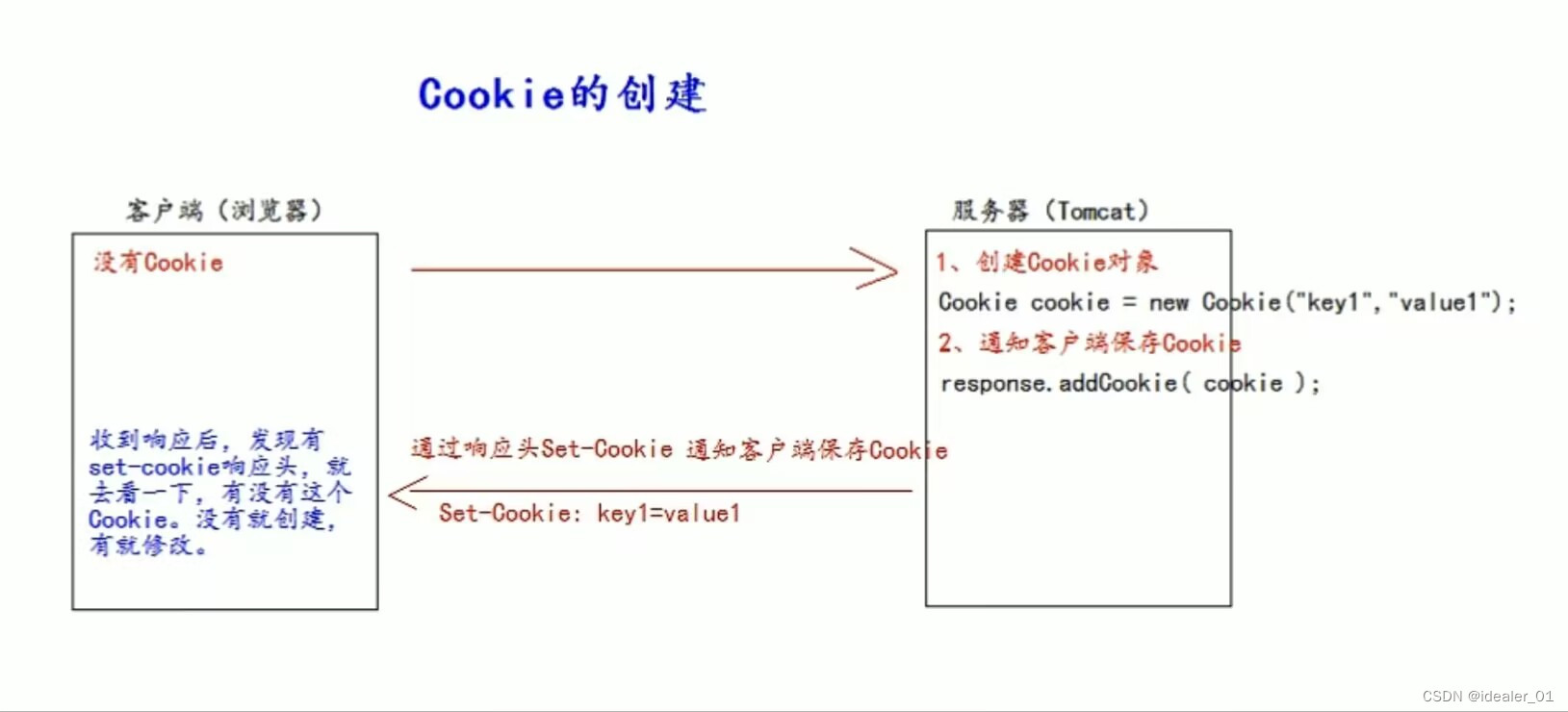
c)服务器如何获取Cookie
服务器获取客户端代码中只需一行代码
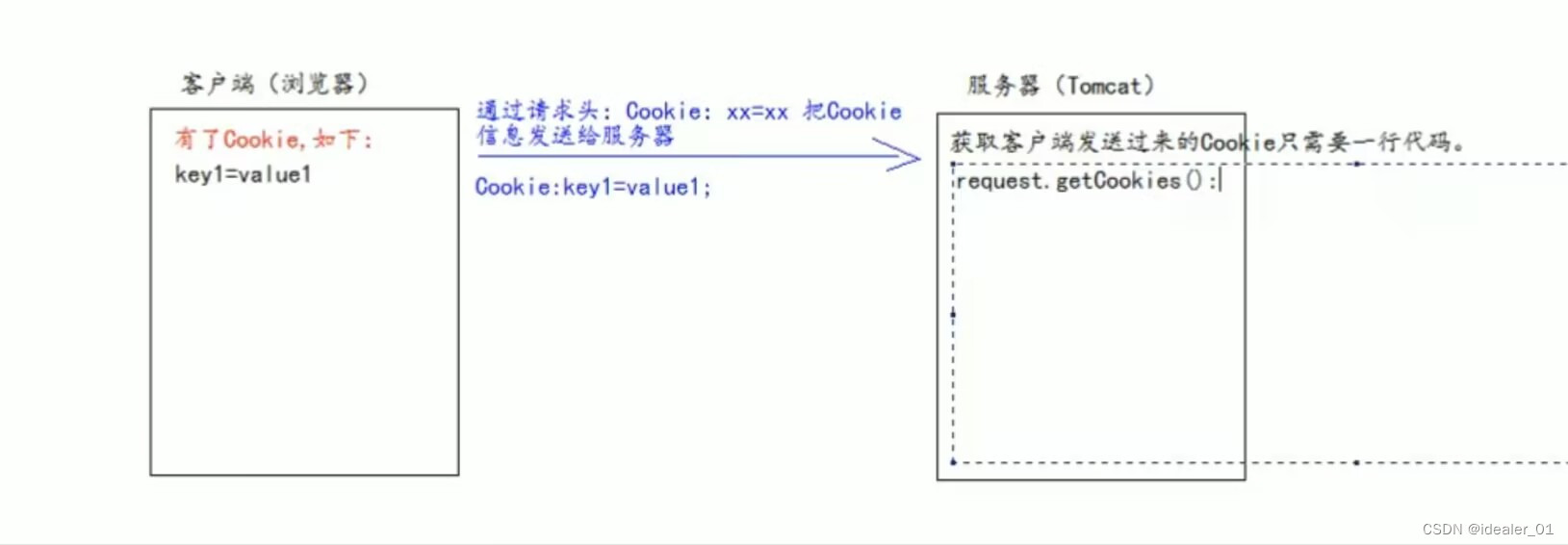
protected void getCookie(HttpServletRequest req, HttpServletResponse resp) throws ServletException, IOException {
Cookie[] cookies = req.getCookies();
Cookie iwant = null;
for (Cookie c:
cookies) {
resp.getWriter().write("Cookie["+c.getName()+"="+c.getValue()+"]\n");
}
iwant = CookieUtils.findCookie("key1",cookies);
if (iwant != null){
resp.getWriter().write("find the cookie that needs");
}
}
public class CookieUtils {
public static Cookie findCookie(String name,Cookie[] cookies){
if(name == null || cookies == null || cookies.length == 0){
return null;
}
for (Cookie c: cookies) {
//获取特有Cookie
if(name.equals(c.getName())){
return c;
}
}
return null;
}
}d)Cookie值的修改
方案一:
- 先创建一个要修改的同名的Cookie对象
- 在构造器,同时赋予新的Cookie值
- 调用response.addCookie(Cookie);
protected void updateCookie(HttpServletRequest req, HttpServletResponse resp) throws ServletException, IOException {
Cookie cookie = new Cookie("key1","newValue1");
resp.addCookie(cookie);
resp.getWriter().write("Cookie值已完成修改");
}方案二:
- 先查找需要修改的Cookie对象
- 调用setValue方法赋予新的Cookie值
- 调用response.addCookie()通知客户端保存修改
protected void updateCookie(HttpServletRequest req, HttpServletResponse resp) throws ServletException, IOException {
Cookie key2 = CookieUtils.findCookie("key2", req.getCookies());
if (key2 != null){
key2.setValue("newValue2");
resp.addCookie(key2);
resp.getWriter().write("Cookie值已完成修改");
}
}f)Cookie的生命控制
Cookie的生命控制指的是如何管理Cookie什么时候被销毁(删除)
setMaxAge() 设置Cookie的最大生存空间,正数表示指定的秒数后过期,负数(默认-1)表示浏览器关闭后Cookie被删除,0表示马上删除Cookie
//默认生命周期为浏览器关闭时销毁
protected void defaultLife(HttpServletRequest req, HttpServletResponse resp) throws ServletException, IOException {
Cookie cookie = new Cookie("defaultLife", "defaultLife");
cookie.setMaxAge(-1);//设置存活时间
resp.addCookie(cookie);
}
//立即销毁
protected void deleteNow(HttpServletRequest req, HttpServletResponse resp) throws ServletException, IOException {
Cookie defaultValue = CookieUtils.findCookie("defaultLife", req.getCookies());
if(defaultValue != null){
defaultValue.setMaxAge(0); //立刻删除
resp.addCookie(defaultValue);
resp.setContentType("text/html;charset=UTF-8");
resp.getWriter().write("defaultLife的Cookie已经被删除");
}
}
//生存一个小时
protected void life3600(HttpServletRequest req, HttpServletResponse resp) throws ServletException, IOException {
Cookie cookie = new Cookie("life3600", "life3600");
cookie.setMaxAge(3600);
resp.addCookie(cookie);
}g)Cookie有效路径Path的设置
Cookie的path属性可以有效的过滤哪些Cookie可以发送服务器,哪些不发。
path属性是通过请求的地址来进行有效的过滤。
CookieA Path=/工程路径
CookieB Path=/工程路径/abc
请求地址:
http://ip:port/工程路径/a.html:CookieA发送,CookieB不发送
http://ip:port/工程路径/abc/a.html:CookieA发送,CookieB发送
protected void testPath(HttpServletRequest req, HttpServletResponse resp) throws ServletException, IOException {
Cookie cookie = new Cookie("Path1", "path1");
//getContextPath()得到工程路径
cookie.setPath(req.getContextPath()+"/abc"); // ====> /工程路径/abc
resp.addCookie(cookie);
}h)Cookie练习---免输入用户名登录
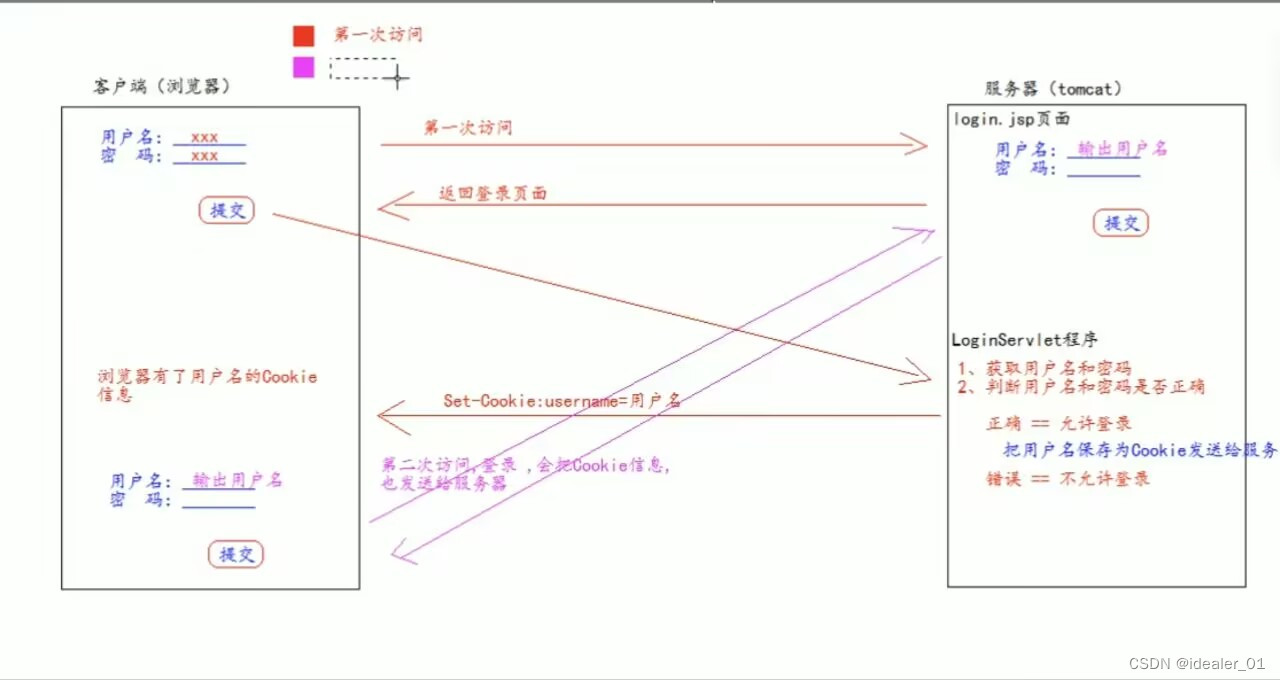
public class LoginServlet extends HttpServlet {
@Override
protected void doGet(HttpServletRequest req, HttpServletResponse resp) throws ServletException, IOException {
String username = req.getParameter("username");
String password = req.getParameter("password");
if("lili".equals(username) && "123456".equals(password)){
Cookie username1 = new Cookie("username", username);
username1.setMaxAge(60*60*24*7);
resp.addCookie(username1);
System.out.println("登录成功");
}else {
System.out.println("登录失败");
}
}
}
<body>
<form action="http://localhost:8080/CookieAndSession/lg" method="get">
用户名:<input type="text" name="username" value="${cookie.username.value}"> <br>
密码:<input type="text" name="password"> <br>
<input type="submit" value="登录">
</form>
</body>2.Session
a)什么是Session
1.Session就是一个接口(HttpSession)。
2.Session就是会话。用来维护客户端和服务器之间关联的一种技术。
3.每个客户端都有自己的一个Session会话。
4.Session会话中,我们经常用来保存用户登陆之后的信息。
b)如何创建Session和获取(id号,是否为新)
Request.getSession():
第一次调用是创建Session
之后调用是获取前面创建好的Session对象
isNew():判断是不是刚创建出来的(新的)
true 表示刚创建
false 表示获取之前创建
每个会话都有一个身份号码(ID值),且唯一,通过getId()得到Session的id值
protected void createSession(HttpServletRequest req, HttpServletResponse resp) throws ServletException, IOException {
//创建或获取Session
HttpSession session = req.getSession();
//判断是否是新创建的
boolean aNew = session.isNew();
//获取Session的唯一id
String id = session.getId();
resp.setContentType("text/html;charset=UTF-8");
resp.getWriter().write("得到的Session的id是"+id+"<br>");
resp.getWriter().write("这个Session是否是新创建的"+aNew);
}c)Session域数据的存取
protected void setAttribute(HttpServletRequest req, HttpServletResponse resp) throws ServletException, IOException {
req.getSession().setAttribute("key1","value1");
}
protected void getAttribute(HttpServletRequest req, HttpServletResponse resp) throws ServletException, IOException {
Object key1 = req.getSession().getAttribute("key1");
resp.setContentType("text/html;charset=UTF-8");
resp.getWriter().write("从Session中获取的数据为"+key1);
}
d)Session生命周期控制
setMaxInactiveInterval()设置Session的超时时长(以秒为单位)和getMaxInactiveInterval()获取Session的超时时长。正数是设定Session超时时长,负数是永不超时
protected void defaultLife(HttpServletRequest req, HttpServletResponse resp) throws ServletException, IOException {
int maxInactiveInterval = req.getSession().getMaxInactiveInterval();
resp.setContentType("text/html;charset=UTF-8");
resp.getWriter().write("默认时长为"+maxInactiveInterval+"s"); //1800s
}在Tomcat的web.xml文件中:
<session-config>
<session-timeout>30</session-timeout>
</session-config>可以在项目的web.xml文件中进行修改项目Session的默认时长
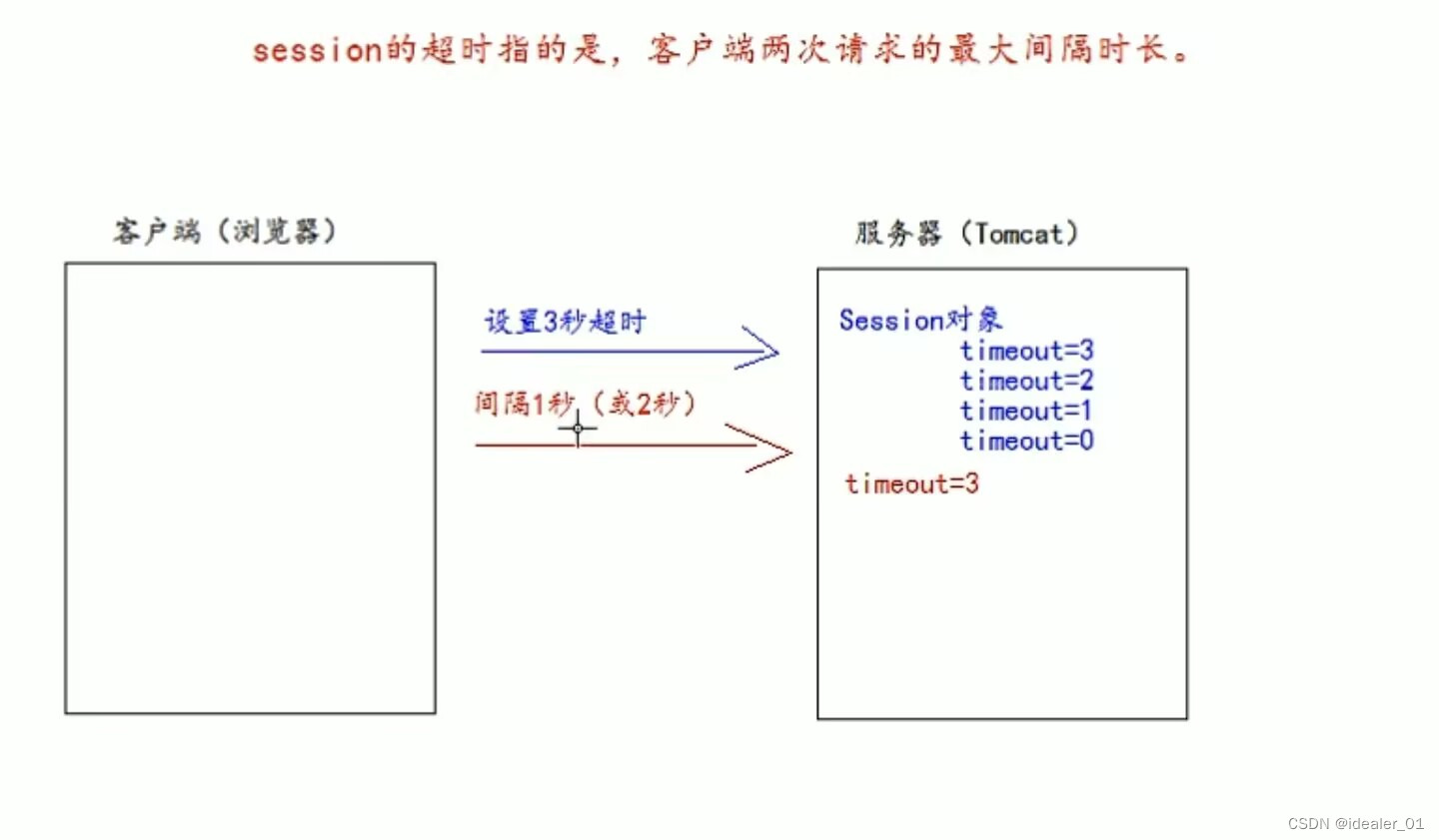
e)浏览器和Session之间关联的技术内幕
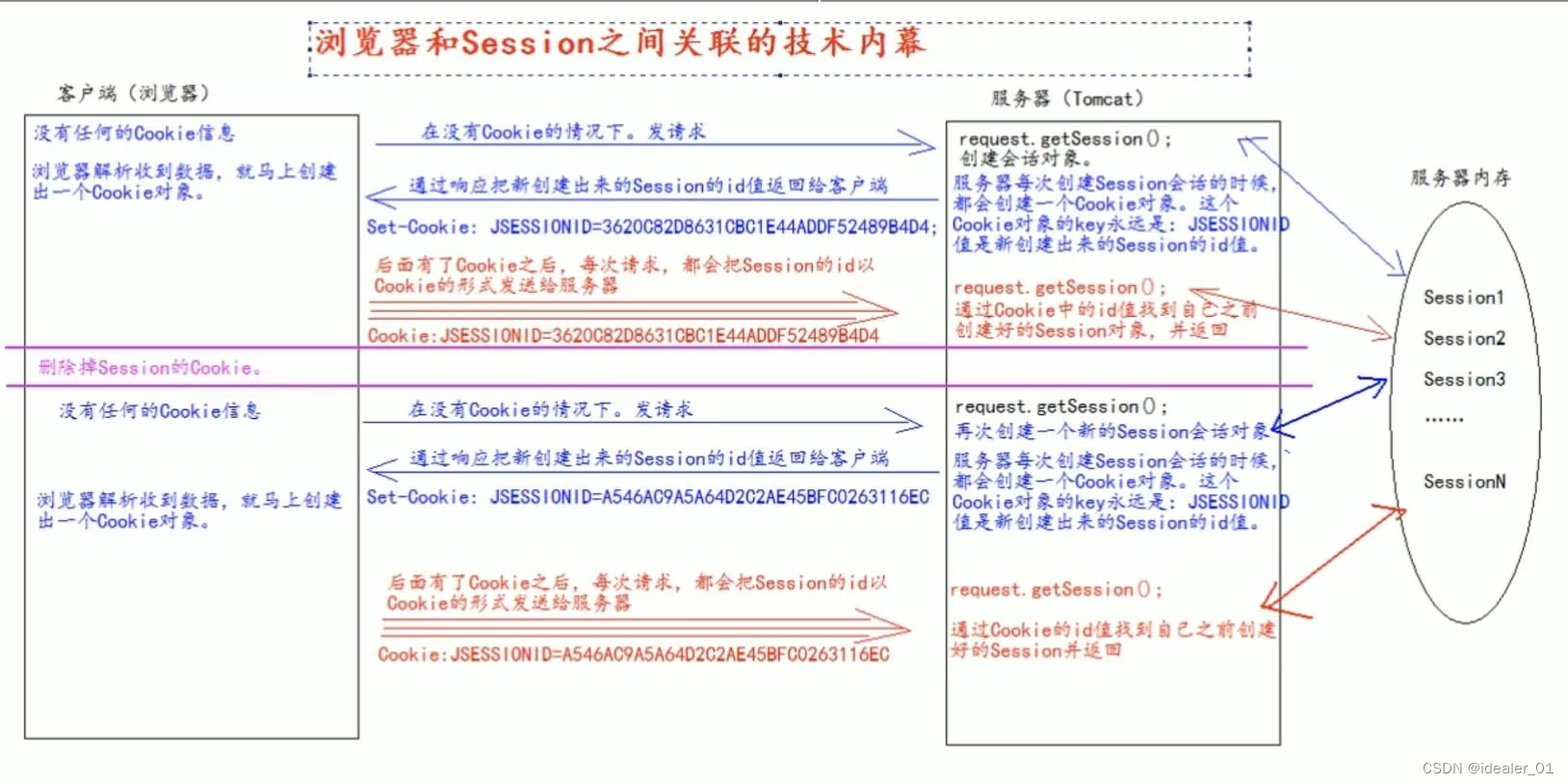
























 16万+
16万+











 被折叠的 条评论
为什么被折叠?
被折叠的 条评论
为什么被折叠?








